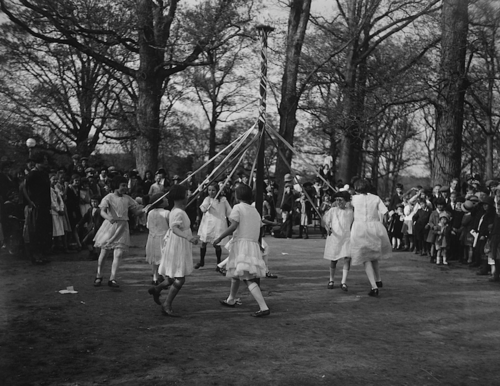May Day in 1924 was a surprisingly big deal
Today is May Day, a springtime celebration that over the past century has transformed into a time to recognize the importance of play (and playgrounds to play on) for children. In 1924, DC had quite the May Day commemoration.

Maypole dance at a DC playground on May 1, 1924. Photo from the Library of Congress.
The playground movement, which latched onto May Day as its annual events became more established, led to the founding of the Playground Association of America (PAA) in 1906. The PAA’s basic belief was that playgrounds were as much a necessity to children’s physical and emotional health as schools. Due in large part to the PAA’s support and assistance, the number of municipalities with playgrounds in America grew from 90 in 1907 to 531 in 1910.
Susie Root Rhodes, the District’s playgrounds supervisor took extra efforts to make May Day a success in 1924 because it coincided with the American Child Health Association’s Health Week.
Rhodes began planning for May 1st two months in advance, organizing festivities at 26 playgrounds across the city in places that included Park View, Bloomingdale, McKinley, and Rosedale, to name just a few.
“Fairies, flowers, and queens, personified in several hundred children,” wrote the Washington Post in the lead up.
The day began at 9:00 am, when three little children from the Child Welfare Society hung a May basket for First Lady Grace Coolidge on the north door of the White House. After placing the basket, the children were running down the steps when Mrs. Coolidge called them back to thank them. She hugged and kissed James Owens, the youngest among them.
“I once had a little boy like you,” she told him.
At Keith’s, a historical theater close to the White House, Grace Abbott of the US Children’s Bureau spoke for an hour. The Children’s Bureau was the first federal agency within the US government—and the world— to focus exclusively on improving the lives of children and families, tackling issues like infant mortality, the birth rate, orphanages, juvenile courts, and diseases that are common among children.
Later in the day, celebrations moved toward city playgrounds, where May queens who were elected by friends from their neighborhood playground presided over 4:00 pm festivals.

May Queen Margaret Appleby (center) on the Park View playground on May Day in 1924. Photo from the Library of Congress.
During their fleeting reigns, May Queens watched over athletic contests, folk dances, the dances of the flowers and fairies, and the maypole. Events ended at 6:00 pm.
The District’s May Day celebrations of days past were, at their core, a public voice of support for quality playgrounds and organized programming around the city. Both are still important to residents today.
